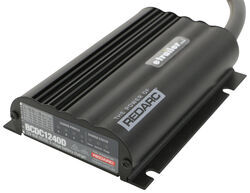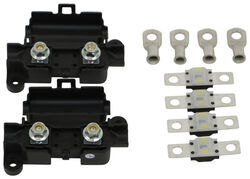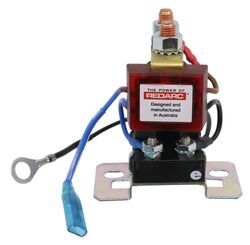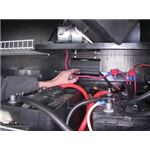
Comparing CTEK D250S and SmartPass vs Redarc DC-DC Charger
Question:
I had a few last questions Iwanted to get clarity on: 1 Tthe Redarc will put out 40A while the CTEK2505S with the Smart Pass will allow 80A SmartPass or 100A sum of two CTEK parts? 2 I can charge one or two batteries more quickly with the CTEK with SmartPass vs the Redarc? Just wanted to confirm difference and maybe this justifies the price difference. 3 I got from a previous question I asked that the maximum input on the Solar side for the CTEk was 25A. If I attach 3 100W solar panels at 12V or 13V, Im ok on the CTEK at about 25 or 23 amps. I wanted to know what the input limit was on the Redarc. I looked at the manual and all it says is that I can have an input voltage of 9-23 or 24V, but not readout on the max input amps allowed. 4 You previously indicated that you preferred the redarc over the CTEK2505S, and on its own, I get that redarcs specs are better, but if you add the CTEKSmart Pass to the mix, it would appear that the CTEK has more output than the Redarc if Im considering having 2 spare batteries to charge with 2 or 3 solar panels. Wanted to get your final thoughts here. Thanks again for your help
asked by: Frank
Expert Reply:
I reached out to my contact at CTEK and the CTEK D250S Dual Battery Charger 12V- 20a, 5 step, Heavy Duty CTEK40186 (discontinued) does utilize the Maximum Power Point Tracker (MPPT) as well. When partnered with the (discontinued) Smartpass CTEK56676 you will be able to run your fridge/freezer as you stated. The Redarc In-Vehicle BCDC Battery Charger # 331-BCDC1240D will also be able to accomplish this so it is a better option for this application. You will also need the fuse kit # 331-FK60 for this installation.

Products Referenced in This Question
Redarc In-Vehicle BCDC Battery Charger - Dual Input - DC to DC - 12V/24V - 40 Amp
- Battery Charger
- Battery Charger
- RV/Camper
- Trailer
- 200 Ah
- Charges/Maintains
- 12V
- Solar Panels to Auxiliary Battery
- Vehicle Battery to Auxiliary Battery
- Redarc
more information >
60-Amp MIDI Fuse Kit for Redarc In-Vehicle 40-Amp BCDC Battery Charger
- Accessories and Parts
- Battery Charger
- Fuse Kit
- Redarc
more information >
Redarc Smart Start Battery Isolator - 12 Volt - 100 Amp
- Battery Charger
- Battery Isolators
- 12V
- Vehicle Battery to Auxiliary Battery
- Redarc
more information >
Product Page this Question was Asked From
Redarc In-Vehicle BCDC Battery Charger - Dual Input - DC to DC - 12V/24V - 40 Amp
- Battery Charger
- Battery Charger
- RV/Camper
- Trailer
- 200 Ah
- Charges/Maintains
- 12V
- Solar Panels to Auxiliary Battery
- Vehicle Battery to Auxiliary Battery
- Redarc
more information >
Featured Help Information
Instructions
Miscellaneous Media

Continue Researching
- Shop: 40-Amp MIDI Fuse Kit for Redarc In-Vehicle 25-Amp BCDC Battery Charger
- Shop: Redarc Smart Start Battery Isolator - 12 Volt - 100 Amp
- Shop: Go Power Solar Cable Entry Plate for MC4 Cables
- Shop: 60-Amp MIDI Fuse Kit for Redarc In-Vehicle 40-Amp BCDC Battery Charger
- Shop: Redarc MC4 Output Cable with Male and Female Connectors - 16' Long
- Shop: Go Power Solar Cable Entry Plate with Red and Black MC4 Cables - 25' Long
- Video: Redarc 60-Amp MIDI Fuse Kit Review
- Shop: Quick Fist Riser - Qty 2
- Search Results: quick fist
- Video: Review of Quick Fist Tie Down Straps - QF40050
- Q&A: What Gauge Wire Works With The Redarc In-Vehicle 40-Amp BCDC Battery Charger
- Search Results: redarc bcdc
- Search Results: sewer hose carrier
- Search Results: redarc
- Search Results: crimping tool
- Search Results: crossfire
- Search Results: renogy
- Q&A: Will TorkLift HiddenPower Battery Mount Hold Group 31 Battery?
- Video: Redarc In-Vehicle BCDC Battery Charger Review
- Shop: Roof Rack
- Q&A: What is the Track Spacing for the Rhino-Rack Universal Pioneer Platform Rack
- Article: Tech Bulletin: Redarc - Installing a BCDC1212T on a Dump Trailer
- Q&A: Can Redarc BCDC Charger Be Used with 7-Way Connector to Charge Trailer Battery
- Q&A: Do 7-Way Trailer Connectors have Amp Ratings for Pins or the Whole Socket
- Article: Trailer Wiring Diagrams
- Article: How to Charge a Trailer Battery While Driving: 3 Common Problems (And How to Fix Them)
- Article: Wiring Trailer Lights with a 7-Way Plug (It's Easier Than You Think)
- Q&A: How to Charge a Trailer Battery Through a 7-Way Connector
- Article: Trailer Lighting Requirements
- Q&A: Backing Plates And Wheel Straps For Securing Vehicles In Enclosed Trailer With E-Tracks










Frank
2/6/2018
I had a few last questions Iwanted to get clarity on: 1 Tthe Redarc will put out 40A while the CTEK2505S with the Smart Pass will allow 80A SmartPass or 100A sum of two CTEK parts? 2 I can charge one or two batteries more quickly with the CTEK with SmartPass vs the Redarc? Just wanted to confirm difference and maybe this justifies the price difference. 3 I got from a previous question I asked that the maximum input on the Solar side for the CTEk was 25A. If I attach 3 100W solar panels at 12V or 13V, Im ok on the CTEK at about 25 or 23 amps. I wanted to know what the input limit was on the Redarc. I looked at the manual and all it says is that I can have an input voltage of 9-23 or 24V, but not readout on the max input amps allowed. 4 You previously indicated that you preferred the redarc over the CTEK2505S, and on its own, I get that redarcs specs are better, but if you add the CTEKSmart Pass to the mix, it would appear that the CTEK has more output than the Redarc if Im considering having 2 spare batteries to charge with 2 or 3 solar panels. Wanted to get your final thoughts here. Thanks again for your help